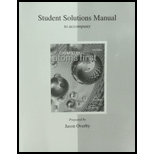
Concept explainers
Interpretation: The process that makes the stratosphere region in atmosphere as high should be explained.
Concept Introduction:
Atmosphere: The atmosphere is defined as air that is layer of gases which surrounds the earth due to gravity of earth.
The earth atmosphere consists of layers such as thermosphere, mesosphere, stratosphere and troposphere depending on the temperature and its composition.
Thermosphere:
It is the top most layer in atmosphere which has high temperature than all other layers present in atmosphere. The high temperature is due to the heat released by the reactions like continuous attack of
Mesosphere:
It is layer next to thermosphere that is the layer below the thermosphere. The increasing temperature for this layer with respect to decreasing height is due to the presence of less concentration of ozone and other gases in it.
Stratosphere:
It is found below the mesosphere layer in which the concentration of ozone and other gases are high.
Troposphere:
The layer is below stratosphere layer and it is closest to the earth surface. It is the thinnest place which is responsible for all weather conditions since it contains almost all amounts of water vapor with it.
To explain: The process for increased temperature in the layer stratosphere.
Want to see the full answer?
Check out a sample textbook solution
Chapter 21 Solutions
Student Solutions Manual For Chemistry: Atoms First
- Explain the difference between the effects of ground- level ozone and stratospheric ozone. Why is one beneficial to human life, whereas the other is not?arrow_forwardexplain the formation of ozone layer in the stratosphere with the chemical reactions.arrow_forwardwhat properties of CFC's make them ideal for various commercial application but also make them a long-term problem in the stratosphere?arrow_forward
- Chemistry: Matter and ChangeChemistryISBN:9780078746376Author:Dinah Zike, Laurel Dingrando, Nicholas Hainen, Cheryl WistromPublisher:Glencoe/McGraw-Hill School Pub Co

 Chemistry for Engineering StudentsChemistryISBN:9781285199023Author:Lawrence S. Brown, Tom HolmePublisher:Cengage Learning
Chemistry for Engineering StudentsChemistryISBN:9781285199023Author:Lawrence S. Brown, Tom HolmePublisher:Cengage Learning  Chemistry: The Molecular ScienceChemistryISBN:9781285199047Author:John W. Moore, Conrad L. StanitskiPublisher:Cengage Learning
Chemistry: The Molecular ScienceChemistryISBN:9781285199047Author:John W. Moore, Conrad L. StanitskiPublisher:Cengage Learning Chemistry & Chemical ReactivityChemistryISBN:9781133949640Author:John C. Kotz, Paul M. Treichel, John Townsend, David TreichelPublisher:Cengage Learning
Chemistry & Chemical ReactivityChemistryISBN:9781133949640Author:John C. Kotz, Paul M. Treichel, John Townsend, David TreichelPublisher:Cengage Learning




